Book Reviews
Books Reviewed:
»Ratio: The Simple Codes Behind the Craft of Everyday Cooking, by Michael Ruhlman
»A Platter of Figs by David Tanis
»Veganomicon:The Ultimate Vegan Cookbook, by Isa Chandra Moskowitz and Terry Hope Romero
»Artisan Bread in Five Minutes a Day: The Discovery that Revolutionizes Home Baking, by Jeff Hertzberg and Zoe Francois
»Heirloom: Notes from an Accidental Tomato Farmer, by Tim Stark
The Garden Primer: The Completely Revised Gardener’s Bible, by Barbara Damrosch
The Cornbread Gospels, by Crescent Dragonwagon
Knife Skills Illustrated: A User’s Manual, by Peter Hertzmann
In the Kitchen
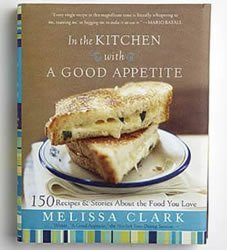 with a Good Appetite: 150 Recipes and Stories About the Food You Love, by Melissa Clark
with a Good Appetite: 150 Recipes and Stories About the Food You Love, by Melissa ClarkHyperion (2010)
ISBN: 1401323766
List Price: $27.50 (U.S.)
»View a recipe from In the Kitchen with a Good Appetite
Melissa Clark’s new cookbook, In the Kitchen with a Good Appetite. is a sneaky little book.
At first glance, I was not excited. Jokes about food porn persist for a reason: just take a look at my cookbook collection if you don’t believe me. We like pining away after images of perfectly prepared foods that will never look at lush, as ripe, as juicy, or as perfectly plated in our own kitchens, no matter how seriously we take ourselves. In The Kitchen with a Good Appetite is elegantly laid out, with a muted sea-green palette, a combination of clean, Cambria and Calibri fonts printed on rich (sustainably forested) linen pages– but there are no pictures. Not even an insert.
It’s while I was pondering that absence that the book started pulling me in. Melissa Clark is an artful story teller, and this really is a book of stories punctuated by recipes. If this book feels plot driven, it’s because Clark knows a thing or two about that: after testing the waters as a chef, Clark decided she’d rather write about food than prepare it (professionally speaking, at least), so she enrolled at Columbia University and earned an MFA in Creative Writing. In the Kitchen with a Good Appetite is her 29th cookbook and its title echoes her widely read New York Times Dining section column, “A Good Appetite”. Her prose is confident and unapologetic, and her self-revealing parables are short (I have so much to learn from her), funny and forward-looking. Each one evolves effortlessly into a recipe that’s generously shared, kitchen tragedies and all.
And those stories work a funny magic: they paint an experience more fully than a full-color photo ever will. Clark tells us about her family’s food-sharing ritual of taking a bite and then passing their plates “Clark-wise”, or about how, when she and her husband were courting, she peered into his fridge to find nothing quite edible, save for a solitary, floating preserved lemon. Like any wordplay worth its sea salt, these stories transport us. She launches into a tale about how her mother refuses to throw away food, even the wilted pile of pale watercress salad, leftover from the night before. Naturally, there is no other place for these stories to end except with a recipe.
A paragraph in and we begin to anticipate it; two, and suddenly we’re there, all senses charged. These stories become ours, because she gives them to us, and suddenly we can remember what it tasted like when our oldest friend brought us real Irish soda bread (which does not contain raisins, in case you were wondering). We can smell the cinnamon, taste the springy texture, and we can hear the hissing of the oven, or the oil in the skillet, or the steam rising from the pot. By the time we’ve reached the recipe, we’re hungry, and deeply attached to the idea of making that dish exactly.
Chances are, we’ll be able to, too. These foods are prepared with the things that we’ll already find in the kitchen, or the backyard, or, if we must venture out, at the corner market. These recipes are not designed, they’re remembered and sometimes lovingly altered. And they’re compelling. Once you start in, perhaps you’ll find yourself, like me, driven to keep on cooking. So far, I’ve used Clark’s recipes to craft these dishes:
- Red Lentil Soup with Mint, Tomato and Lemon
- Cheesy Baked Pumpkin with Gruyere
- Browned Butter Maple Cornbread with Fresh Corn Kernels
- Raw Tuscan Kale with Chiles and Pecorino
- Sweet Tofu Salad with Spicy Mustard and Pickles
- St. Mark’s Gooey Honey Butter Cake with Lemon and Cinnamon (I am from St. Louis, after all. And you know what? Hers is better….)
- Impossibly Fudgy Brownies with Chile and Sea Salt
This cookbook is a delightful experience , every bit as much literary as it is culinary. It’s meant to be read, digested, used, treasured and, like the recipes that fill its pages, passed around and shared.
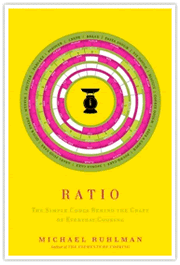 Ratio: The Simple Codes Behind the Craft of Everyday Cooking, by Michael Ruhlman
Ratio: The Simple Codes Behind the Craft of Everyday Cooking, by Michael RuhlmanScribner (2009)
ISBN: 978-1416566113
List Price: $27.00 (U.S.)
»View a recipe from Ratio
High school algebra was the one class in which I ever got a D, and then I followed up that stunt by lying my way to Mexico. Told my dad I’d pulled a B- so that I could go on my spring break trip, and by the time the report card arrived in the mail, I was the focus of a small health emergency unfolding in a medically equipped hut in the center of the Yucatan Jungle. My parents were so happy to see me alive that I never even needed the five-foot straw sombrero I’d haggled down to 55 pesos.
I still hate math. But I did need it for haggling. And every day, in some way, I need it for cooking too.
Along, then, comes Michael Ruhlman’s Ratio, and at last I find myself inspired to at least breathe deeply in the face kitchen math. Here’s why. Ratio: The Simple Codes Behind the Craft of Everyday Cooking (Scribner, 2009) is a culinary Golden Compass – it gives the home chef access to the inner workings of food. Before I go on though I better say this: In order for this to be much help, you already need to be pretty familiar with the outer workings of it. This is a book for those among us who aim to understand what we’re doing when we’re fiddling around in the kitchen.
Ruhlman’s idea is an elegant one: great food is based upon a reliable ratio of the ingredients. When you know the simple proportions of one ingredient to another, you’ve nailed the backbone of culinary craft. Easy as 3:1:2. Three parts flour, 1 part fat, 2 parts liquid, that is. That’s the ratio for biscuit dough, as opposed to pie dough, which is 3 parts flour to 2 parts fat to 1 part liquid.
And that’s the real magic here. Drag the flour from your pantry, the butter or oil and the eggs from the fridge, and get some water ready and set up shop. Grab a large bowl, and start mixing. By shifting the ratio of flour to fat or liquid, with the addition or subtraction of egg, or by using one kind of fat rather than another, you can whip up biscuits, pie dough, pate a choux, bread, pasta, muffins, fritters, popovers or pancakes. Toss in some sugar and the possibilities include cookies and any number of cakes.
Of course, it’s not quite that simple. Bread requires yeast, and unless you’re trying for manna, baked goods call for leavening. Salt is requisite, and no matter what you’re making, if you fail to spice things up then you’ll have pretty dull, plodding food. You won’t find guidance about leavening, herbs, extracts, cheeses or other flavors here. Rather, Ruhlman says, this kind of expertise comes from experience, and experience is an important part of this equation. Consider his statement that the basic, unadorned 1:2:3 cookie dough is “a good recipe to do once so that you can understand what a cookie is.” The implication being that you’ll never do it again.
But Ruhlman does go on at length to explain the function of the other ingredients, if not their measurements, and he provides alternate recipes that have had the ratios tweaked so that we might begin to understand what happens when you modify the balance of ingredients. And the book goes far beyond dough recipes. Ratio is divided into sections: Doughs and Batters, Stocks, Meat-related Ratios, Fat-Based Sauces (including vinaigrette, mayonnaise and hollandaise), and the Custard Continuum (which has free-standing custard at one end and caramel and chocolate sauces at the other).
If you can get a handle on the ratios, then there’s a lot of freedom here. Say you want to make a little bit of bread – or a whole bunch. Rather than finding a recipe to suit your needs, or going through the hassle of modifying one, simply measure out the amount of flour you need. You have 21 ounces? If the ratio is 5 parts flour to 3 parts water then you’ll need… well, you’ll need… um… See, that’s why this book’s applicable value is limited for me. At least until the US goes metric.
I still love this book though. If you, too, are severely mathematically stunted, and if, unlike me you don’t live with a numbers whiz like Simon, I’ll still gamble that this book will be an incredibly enlightening resource (even though gambling is a numbers game). For one thing, every chapter is filled with gems and nuggets that you can carry straight into the kitchen. There’s as much on technique and chemistry as there is on ingredients, and technique is more than half the equation.
For example, in the section on vinaigrette, Ruhlman writes extensively about the order in which ingredients should be combined as well as how to attain just the right emulsification. As for stocks, he asserts that they deserve extraordinary attention since they infuse food with that je ne sais qua that separates home cooking from restaurant quality cuisine. Appropriately then, he covers techniques for extracting flavor, simmering times, and temperatures (stock should never boil), as well as methods for thickening and salting.
Every page of the book is a joy to read. Engaging, sometimes flip, and always deeply serious about food, Ruhlman writes with wit, honesty, and an almost ruthless candor. The book is an aesthetic paradox of a cookbook, heavy on text, relatively light on the recipes, yet punctuated throughout with the dramatic, artful black and white photography of Ruhlman’s wife, Donna Turner Ruhlman. And the ratio of photos to text achieves just the right balance.
One of my rules about cooking (and writing) is to shamelessly break all the rules. But first you have to learn them – and understand them. Regardless of your skill level, Ratio gives you the tools for knowing, on a very elemental level, how to cook, and it provides inspiration as the why. Ruhlman’s culinary ratios hand you the plot of land and the bricks and mortar. The tiles, the hardwoods, the moldings and soffits and triple-hungs, those are up to you. And if you can achieve confidence in your ability to manipulate the formula, suddenly the skylight’s the limit
A Platter of Figs by David Tanis
Artisan (October 1, 2008)
ISBN: 978-1579653460
List Price: $35.00 (U.S.)
»View recipes from A Platter of Figs
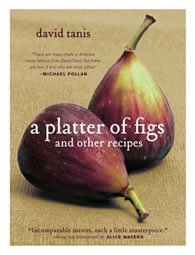
I can’t just follow a recipe.
When it says “1 teaspoon paprika”, I shake in a generous helping. Sometimes I gratuitously use it smoked. Five cloves of garlic, sautéed, sometimes with the mildest of onions, is the basis for just about everything I make – even if it doesn’t call for garlic at all. I have a kitchen scale, but that’s more for figuring out what I’m eating, not for measuring out the ingredients I stir into the pot. I travel the kitchen with my senses and foods become the manifestation of my instincts. I love cookbooks, but the truth is, I’m not that much of a cookbook kind of girl anymore.
Except that the relatively recent focus on local and seasonal foods is changing that. That’s because these books emphasize a way of being in the kitchen, a relationship to food, rather than step by step instructions for adding this and getting that. No book embodies this idea more to me though than David Tanis’s A Platter of Figs. This book is less about how to make food and more about how to eat it. How to love it, in the way that you can only love something you truly, intimately know.
Tanis explains this best in his introductory paragraph, when he writes: Do you really need a recipe for a platter of figs? No. Is that the point? Yes. Does it have to be more complicated than that? Not really. Yet to serve the figs, you need to know about ripeness and seasonality – the seasons of the garden, and you need to know your figs.
And Tanis would know. He’s a chef, a cook, a teacher and an author, and his love affair with food began early. When other kids were learning to pop wheelies, he was perfecting the art of buttering toast, and choosing the perfect plate to serve it on. His obsession with the details of food led him to San Francisco, and he is best known for his work with Chez Panisse. He earned his way into Alice Waters’s kitchen by serving her the simplest, purest, and yet most “seriously whimsical” lunch one day when she said she was hungry. She was so impressed that she put him upstairs to cook for the Café at Chez Panisse, and he’s been working with her in some capacity ever since. These days he splits his time between Paris, where he writes and hosts private dinners, and San Francisco, where he is chef at Chez Panisse.
To Tanis, the best meals are simple and straightforward, seasonal, fresh. These are not new concepts, (though Tanis was one of the first to introduce the notion to the culinary world, and at a time when highly crafted food was the rage). The thing that sets the book apart, then, is its truly contagious celebratory tone. This book is full of stories – stories of experimentation, stories of shopping, cooking and eating with friends, stories of late nights of wine and conversation, even stories of failure. It reads like a novel, a love story, and the reader feels like the recipient of the love.
As any cookbook must be, this one is brimming with lovely recipes, organized in menus that are built around the seasons. For example, Spinach Cake with Herb Salad, or Wild Salmon with Vietnamese Cucumbers and Rose-scented Strawberries (spring), and for summer, a menu of Melon and Figs with Prosciutto and Mint, with Deconstructed Nicoise Salad and Lavender Honey Ice Cream. The recipes are radically simple, meant for sharing with the people who matter most, and firmly rooted in one solid idea: creating a meal means creating your own reality.
As Tanis writes, a party can be any gathering of eaters at a table. Or a couch and a handful of chairs, as the case may be in our house. Or a spot of shade under a tree. Cooking, of course, is really about eating, and eating is about sharing, and this book gives highest honor to both.
»View recipes from A Platter of Figs:
Spinach Egg Cake, Herb Salad and Asparagus Vinaigrette
Veganomicon: The Ultimate Vegan Cookbook by Isa Chandra Moskowitz and Terry Hope Romero
Da Capo Press (October, 2007)
ISBN: 978-1569242643
Price: $27.50 (U.S.)
»View Recipes from Veganomicon
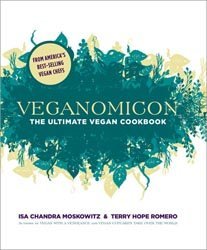 Veganomicon: The Ultimate Vegan Cookbook is a beautiful cookbook full of recipes that genuinely reach two pinnacles of culinary destination: gourmet and comfort food. The recipes also happens to be vegan.
Veganomicon: The Ultimate Vegan Cookbook is a beautiful cookbook full of recipes that genuinely reach two pinnacles of culinary destination: gourmet and comfort food. The recipes also happens to be vegan.
The book has a centerfold of photos that make my stomach rumble, and the book (or my book, anyway) falls open to a tempting shot of spicy tempeh nori rolls. Now, I think I’ve mentioned here how painfully I’ve missed sushi during my vegan days. I’m not a fan of tempeh but I thought I’d give it another go, and in these rolls, it’s quite good. True to their name, the rolls are indeed spicy, as well as creamy, crunchy and nutty. Served up with some avocado-cucumber rolls, they completely satisfied me. Other inspiring recipes in the book include Baked Potato and Greens Soup with Potato-Wedge Croutons, Potato and Kale Enchiladas with Roasted Chile Sauce, Israeli Couscous with Pistachios and Apricots, Cauliflower and Mushroom Pot Pie with Black Olive Crust, Quinoa Salad with Black Beans and Mango, and Mediterranean Style Cashew Cucumber Dip. Really. I don’t need to review this book. I could just rattle off a list of the recipes.
The success of vegan cooking all comes down to the sauce — a good one makes all the difference between a bland vegan dish that cries out for what it’s lacking and one that sings. Although it’s true that Veganomicon has more than enough variations on pesto to get you through three summers, plus the requisite vegan “cheez” sauce recipes (made with nutritional yeast flakes and mustard powder – generally, I find, a pretty solid argument against veganism), the book is teeming with a rich collection of dips, moles, gravies, dressings, salsas and sauces. Some of my favorites include the Chocolate Chile Mole as well as their Green Pepita Mole, a simple Red Wine Roux, Vodka Pasta Sauce, and Mushroom Gravy.
And then we get to dessert. Isa Chandra Moskowitz and Terry Hope Romero, the brain and inspiration behind Veganomicon and the vegan podcast/cooking show Post-Punk Kitchen, are known for their vegan baking. Their first book, Vegan Cupcakes Take Over the World, became an instant cult classic. Some of these cupcakes make it into this book, as well as can’t-possibly-be-dairy-free recipes like the elegant Pistachio Rose-Water Cookies, Almond-Anise Biscotti, and Banana Chocolate Chip Bread Pudding.
Most of these recipes are easy – and fast. And generally they don’t call for any ingredients you won’t already find in a well-stocked foodie’s pantry. Vegan or not, this is a book that I will be turning to over and over again.
»View Recipes from Veganomicon:
Chile-Chocolate Mole and Potato-Kale Burritos
Artisan Bread in Five Minutes a Day: The Discovery that Revolutionizes Home Baking, by Jeff Hertzberg and Zoe Francois
Thomas Dunne Books (November, 2008)
ISBN: 978-0312362911
Price: $27.95 (U.S.)
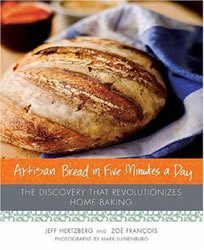 I discovered the Artisan Bread in Five Minutes a Day technique rather by accident. I’d been cooking from Shirley Corriher’s Bakewise. In it, Corriher argues that there is no need to knead yeast dough because it kneads itself as it rises, and hand kneading leads to over-oxidation, which compromises flavor. And who needs that? Still, I was resistant. After all, I’ve been making bread for 15 years and I’ve gotten quite accomplished at it, and every baker knows that the secret is in the kneading.
I discovered the Artisan Bread in Five Minutes a Day technique rather by accident. I’d been cooking from Shirley Corriher’s Bakewise. In it, Corriher argues that there is no need to knead yeast dough because it kneads itself as it rises, and hand kneading leads to over-oxidation, which compromises flavor. And who needs that? Still, I was resistant. After all, I’ve been making bread for 15 years and I’ve gotten quite accomplished at it, and every baker knows that the secret is in the kneading.
Blast it. Corriher was right. And now, thanks to Jeff Hertzberg and Zoe Francois and their lovely, cursed book brimming with way-too-easy yeast dough recipes, the whole world knows it.
The first time I made golden, crusty, batter-free no-knead bread, I assumed it was a fluke. But it was so darn easy that I tried it again, and then again. I was working with one, very basic four-ingredient recipe and though it was a bit tricky since I was flying without a guide — figuring out how long out of the fridge the dough had to rise, how warm it should get, how long cold dough would keep, etc — overall I was pleased with the results I was getting.
And I sure wasn’t telling anyone. I kept right on impressing my friends and family with my homemade bread, and I continued to let them think it was all very hard work.
In November, Thomas Dunne Books gave us Hertzberg and Francois’s Artisan Bread in Five Minutes Day: The Discovery that Revolutionizes Home Baking (November 2007). This beautiful little book takes all the guesswork out of it, and it blew my palate wide open. Never mind that it blew my cover.
Artisan Bread in Five Minutes a Day has recipes for everything bread-like, no exaggeration. The opening chapters tell you all you need to know about no-knead bread: what the different flours do, why it’s okay to skip the kneading and why the bread’s flavor is actually enhanced if the dough rests for several days. Hertzberg and Francois illustrate how to handle and shape bread, how to take it to the right temperature, and most importantly, how to bake it to achieve the coveted crusty European texture. And then we get into the recipes.
The first recipe is the only one you’ll ever really need, a simple, rustic flour-salt-water-yeast bread. Hertzberg and Francois’s recipe for boule turns out a perfect loaf – chewy, moist, crusty, with a lovely, slightly tangy flavor. They offer slight modifications for turning this basic recipe into baguettes, ciabatta and a tartine, and I tried them all. No matter everything I know about the merits and virtues of eating whole grains – this is, and always will be, my favorite kind of bread. Give me a grassy olive oil, some freshly shaved Parmesan, a dash of salt and I’m in simple-carb heaven.
But woman cannot subsist on white bread alone, and Francois and Hertzberg make sure we won’t have to. The rest of the book is filled with all those intimidating-sounding recipes: whole wheat sandwich bread, olive bread, limpa, pumpernickel, walnut-date loaves, flatbread and pizza, Moroccan anise and barley bread, and a dizzying selection of dessert breads, including sticky buns, jam-filled beignets, and chocolate bread.
And no, you don’t have to knead any of it.
To view a recipe from this book, click here. For more information on Artisan Bread in Five Minutes a Day: The Discovery that Revolutionizes Home Baking, or to purchase the book, click here.
Heirloom: Notes from an Accidental Tomato Farmer, by Tim Stark
Broadway Books (available July 15, 2008)
ISBN: 978-0767927062
Price: $24.00 (U.S.)
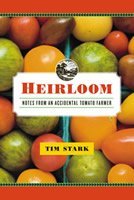
Tim Stark may be a farmer extraordinaire, a curator of the living museum of tomato history, an astute-eyed, quick-thinking dumpster diver, and a bit of a curmudgeon with a whole lot of Tom Sawyer mixed in, but above all this, he is a story teller.
From the opening pages of Heirloom: Notes From an Accidental Tomato Farmer, which actually contained the phrase “this jungle of sumptuous, mismatched love apples”, I knew that I was in the hands of a master of language. And indeed, Tim Stark was narrowly rescued from the life of a starving writer in New York by the life of a seasonally flush farmer with a truck patch. He’d been a struggling fiction writer wrestling existentially in Brooklyn before taking up the spade. Or, as he sums up the birth of his farming life: Out in the (Brooklyn) street one wintry March evening, pacing and frothing over poverty, injustice, and those politely worded impersonal rejection letters that quarterlies dispense the way banks hand out toasters, I came upon a trash dumpster loaded with basement scraps.
And the rest is written in the dirt.
Stark used his dumpster score to build germination trays that filled his NYC flat. When the seedlings grew, as they are known to do, and the landlord evicted them from the brownstone, Stark U-hauled the entire collection to the Pennsylvania family farm where he’d grown up. Doing everything by hand those first years, Stark and his bedraggled and accidental helpers transplanted them into the ground, watered them with watering cans, hand-squashed weeds and relocated bugs. By chance or divine curiosity in the project, Stark rolled in a bumper crop the first year. At a time when tomato was a synonym for red, those mismatched love apples sold faster than he could pull them off the truck at New York City’s Union Square Greenmarket.
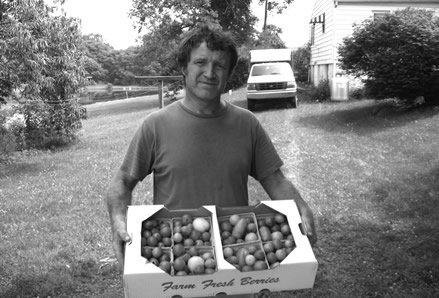
In Stark’s hands, the adventures of an overworked dirt farmer become an eloquent and enticing piece of narrative craft. He admits in the opening chapter that his farm plan, hatched out of debris, was an idea so impractical it bordered on fiction. The book that resulted, then, could only read like a novel, or a fairy tale. The Angela Carter variety, with a heavy emphasis on the witchery, evil lawyers and misguided and inscrutable ogres named Milt Miller who curse and stomp in the foreign cadence known as Pennsylvania Dutch. Indeed, Eckerton Farm is no Sunnybrook, and the memoir is rife with tensions and conflict as well as it is with the joys and wonders that can only be discovered in lumpy purple tomatoes and unevenly-knitted sweaters.
Like any writer worth his MFA, Stark has employed all sorts of narrative tricks to keep the story moving. The chapters weave forward and back in time and change notably in tone from one to the next. His use of language is both lyrical and purposeful. For example, he reveals his father’s alcoholism with this striking sentence: But he was overworked and his vision of a weeping willow-shaded, peony-lined rest cure for his marriage hadn’t taken into account a few critical details, most notably the neon-blinking watering holes mining the route between Allentown and Eckerton.
Though the exhausting life of a farmer is rendered so realistically that it doesn’t take long for my own bones to feel weary, the story nearly floats on Stark’s droll take on the world and the creatures that inhabit it. He tells us with pride that he was once chased to the side of the road by a Primo truck driver, who begged him to remove the Primo logo from his own clattering embarrassment of a tomato truck. Or, for example, his response to a market-goer who disdainfully complained that as hot chilis go, “there’s nothing hot in this whole market.” When Stark offers up a cayenne, the customer snorts: “That does not do much for me.” So what the heck, writes Stark. I hand over the chocolate habanero and Mr. Chile head gulps it down like it’s a sandwich. For a moment he doesn’t seem the least bit affected. But then he starts making this huffing noise. Huffing and puffing with eyes open wide. His mouth opens too, and he tries fanning it with his hand. Then he begins to hop. Hop, hop, hop. “Try milk”, I call after him as he hops away. “Or thumbscrews.”
And then there are the more tender and equally human moments, like when Stark describes daily field trips to “sit in the funny tomato truck” at his young daughter’s request.
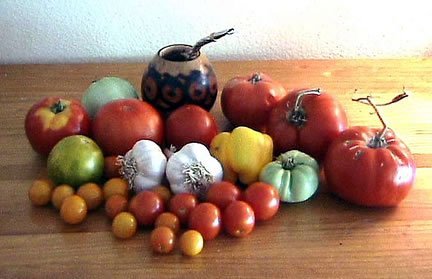
The real test question, of course, is does this book matter to people who aren’t interested in tomatoes? It’s a tricky one to answer since I am, in fact, a seed geek of the most obsessive kind. But the answer, I’m convinced, is yes.
And that’s because, in the end, tomatoes are inseparable from people, and so this is a story about people. Tomato People, those with ancient nightshades in their blood and an affinity for shaly soil, with a lineage so complex and twisting that it’s nothing short of a miracle that they (read, we) exist today. We are all, it seems, tomato people, traveling the same intertwined and evolutionary roads that these seeds covered, facing the same hardships and overcoming the same insurmountable odds, taking this path instead of that, adapting to our environments while fiercely holding onto ourselves, insisting on looking like peaches instead of red tomatoes.
This heirloom of a book will leave you with a revised understanding of the food you see at your local green market, a layered respect for the farmer that got it there, and, inevitably, a feeling of relationship. Line by line, Stark makes a case for the irrefutable connection between the land we inhabit, the food we eat, and the people who bring it to us.
The Garden Primer: The Completely Revised Gardener’s Bible, by Barbara Damrosch (Workman Publishing, 2008)
ISBN: 978-0894803161
Price: $18.95 (U.S.)
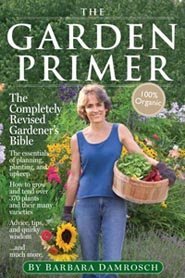
Ordinarily, having to ‘fess up to the fact that I’ve faithfully used — since its original publication — a book that just enjoyed a 20th anniversary reprinting would make me feel old. But admitting that I’ve been dog-earing and mud-smearing Barbara Damrosch’s Garden Primer since 1998 makes me feel visionary.
Back in those days, a solid, sustainability-minded how-to guide for gardening was hard to come by. Back then, my book collection consisted of Ortho’s Guide to Herbicide (because it had full color photos and great info on plant cultivation) and DuPont’s Pest Control (for the great bug photos – this was before Internet, you have to remember). I just skipped over the paragraphs that advocated Diazinon applications (seriously!). I cobbled together what information there was and did the best I could.
Then came the day when I stumbled onto Barbara Damrosch (and her husband, Eliot Coleman). Both of their invaluable books were uncovered used, in a dusty pile in a Portland indy book cellar. All at once, my gardening paradigm lifted off the ground, and likewise, my garden. This was what I had been trying to do all along, only without the formal help. The Garden Primer became my blueprint, my reference, my diagnostic tool and my savior. The 2nd Edition, published just this February (2008), is still all this and then some.
As in that original version, the 2nd Edition provides gardeners at all levels of expertise with all the information that matters. It’s the sort of book that can prop you up while you get started or can point out subtle details that you might be overlooking amidst all your thriving foliage. This book first sets you up to “think like a plant”, then lays the foundation for a garden plan, gives you instructions for maximizing your space, elucidates readers on the various tools for the job, and gives plant by plant descriptions and growing tips.
The cover of the 2nd edition is emblazoned with the words: 100% organic. While both versions of Damrosch’s book very heavily emphasize the sustainable approach, this volume is certainly geared toward the 21st century climate. For example, while Damrosch gives useful and straightforward information on growing a chemical-free lawn, she also spends considerable space pondering whether we even need lawns. Instead she offers chapters on ground covers that could serve as alternatives, including edible and aromatic ones like thyme. She is straightforward and balanced, admitting upfront that ground covers require a larger initial investment. She also gives detailed information about using wildflowers and native shrubs in place of the common lawn.
There is a section on creating a wildlife-friendly garden spaces, and one that pointedly discusses avoiding wildlife-toxic plants. This includes sidestepping invasive and non-native species, which can dramatically alter a landscape (think honeysuckle)
Once again, Damrosch provides a plant-by-plant encyclopedia. Arranged by category (annuals, perennials, veggies, herbs, trees, shrubs, fruits, bulbs, roses, and so on) and then alphabetically, Damrosch offers a botanical history, as well as instructions on site, soil requirements, planting, growing, harvest, varieties, and of course, managing pests and diseases without chemicals or toxins. This time around though, the list of plants and their varieties is greatly expanded and includes disease-resistant varieties, heirlooms, current favorites and native plants. All throughout she emphasizes planning a garden within the context of your regional climate and conditions.
Toward sustainability, Damrosch discusses techniques that are efficient and resource-conserving. Beyond native plants, she goes into row styles, plants for small spaces, mulching and composting.
Damrosch delivers all this without ever losing her intimate, friendly, gardener-next-door narrative style. Though the advice spans the gamut, from the very basic like knocking a plant out of a pot, to the comprehensive, like irrigation systems, you can’t help but feel like a friend has imparted wisdom over a cup of tea and a plate of lavender cookies.
My only wish is that the book were more visual. It’s illustrated throughout with black and white line drawings, but sometimes I really need a picture, more so when it comes to a technique than when I’m trying to identify a pest or ailment. On the other hand, if this were one of those glossy, full-photo volumes, I wouldn’t be so quick to drag it out into the dirt (or, occasionally, use it as a kneepad).
And out in the dirt is where this book really shines. Season after season, year after year, this book will, just like the earlier edition, serve as a quick reference, an on-the-spot problem solver, a practical guide, an over-the-garden-gate friendly adviser, a reassurance, and an inspiration.
The Cornbread Gospels, by Crescent Dragonwagon (Workman Publishing, 2007)
ISBN-13: 978-0761119166
Price: $22.95 (U.S.)
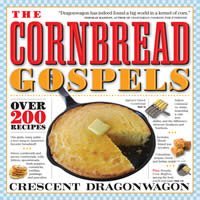
Crescent Dragonwagon knows things about cornbread. She knows, for instance, that it’s got a long and winding history in almost every culture throughout the world. She knows the importance of the corn grinding technique when it comes to yielding the most nutritious, sweetest meal. She knows, of course, that cornbread was made to go with beans. Plus, she just plain knows how to have a good corn-versation.
She also knows that single-food cookbooks can be a hard sell, even if the food is as widely loved as cornbread, and she takes pains to incorporate wit, history, narrative, technique, poetry, human interest, and geography into her collection of vastly different cornbread recipes.
Dragonwagon has a quirky way of putting things. Folks who like cornbread are referred to as “cornbread eating human beings” (as opposed to cornbread eating felines, I suppose). She’s playful, inserting phrases like “kernel of truth” and “cob-bled together”, and even ventures that something is “amaizing”. The prose is rambling in an appropriately Southern way (though cornbread is Northern, too), and unexpectedly refreshing, even if the words sometimes feel plucked from a thesaurus.
But of course it’s the recipes that you’re really here for, and Dragonwagon delivers splendidly. These recipes tie her stories together.. You’ll find instructions for making various traditional cornbreads, as well as pones, scones, arepas, tortillas, waffles, slapjacks, hush puppies, and even cornmeal gingerbread. The recipes are easy to follow and each one comes with a lot of useful hints and techniques. You’ll learn how to season a cast iron skillet, how to choose the right cornmeal for your intentions, what to do with leftover cornbread, and the history and nomenclature of porridge.
The book is divided by geographical regions and by cornbread genres: Some of those include babycakes, yeasted cornbread, spoonbread, rolls, muffins, and even crisp cornbread. Each chapter comes with full menus to accompany the bread (though those recipes aren’t, for the most part, included in the book). She also devotes a chapter to “great go-withs”, and features a section on cornbread and beans. Dragonwagon points out that the beauty of the corn-bean combo is that it’s a complete protein, and this section does offer recipes for the go-withs, which include gazpacho, greens, and North Indian style sarson ka saag, among other things.
Of course, I’d be remiss as a champion of food biodiversity if I didn’t throw in my own caveat: corn is part of the Holy Trinity of agriculture, and it’s also one of the most commonly genetically modified crops. Single strains of three crops – corn, wheat, and soy – dominate this country’s landscape, which may be a disaster waiting to happen. Think Irish potato famine. At the very least, it’s boring and a terrible waste of all sorts of culinary and gastronomical adventure just waiting to be discovered. Dragonwagon does give some attention to less common varieties of corn and cornmeal, and she includes recipes that use blue corn flour, so she seems at least peripherally aware of the issue.
All in all, this book is everything you want to know about making and eating cornbread, and then a whole lot more. Well-written, entertaining, idiosyncratic and surprisingly far-reaching, this is a book that will no doubt earn a prominent place in my kitchen.
Knife Skills Illustrated: A User’s Manual, by Peter Hertzmann (2007)
ISBN-10: 0393061787
I give this book two thumbs up. Thanks to the book, I still have them both. My grandmother gave me this book for Christmas, and I was highly offended. It’s insulting enough that she leaves the room when I’m wielding a knife. She says she can’t stand blood and she might pass out if I ever actually lost a finger. But, okay, truth is I can’t blame her. More than once my nails have become an unwitting part of the dish, and barring a calcium deficiency, that’s no good for anyone. Once I quit acting injured, I was grateful to have the book.
This is not a cookbook, per se, but rather instructions for cooking. Specifically, step by step directives for dismantling food without dissecting your digits. It gives definitions and illustrations for all those techniques you thought you understood but didn’t quite – chopping, mincing, carving, dicing, and julienne. It also gives specific instructions, vegetable by vegetable. Hertzman dishes up some insights that make me laugh out loud, though I’m not sure that was his intent, like “Never hold a knife like a sword” and “A small ruler is a handy kitchen gadget” — this for making sure your 1/8″ cube is a bona fide 1/8″ cube. He also offers wisdom that seem obvious, even though I’d never actually thought of it myself. For example, he suggests cutting an onion lengthwise from root to stem, rather than the traditional crosswise cuts, in order to get the most closely uniform pieces (cutting an onion truly uniform is impossible given its structure).
My only gripe is that the organization of the book is muddled in places. The book graciously gives instructions for both left and right handed cooks, but it gets confusing because the instructions for each are interwoven. The illustrations help reorient the reader (if you’re a righty, it looks downright wrong to see a knife held in the left hand), and all in all this is one of those books that I’ll probably never stop using. Thanks, Gram.
A Celebration of Heirloom Vegetables, by Roger Yepsen (1998)
ISBN-10: 1885183887
This book is an older one, and alas, out of print, but it can still be had from used book dealers, and for quite a steal. This was one of the first books I read on heirlooms, and it’s a virtual bible, with color illustrations, history, recipes, and seed sources. The author earns a double dose of admiration because he actually grew most of the vegetables he showcases and drew the illustrations in the book. A man who can cook, garden and draw pictures of it all! What strikes me now as I page through this book is the difference between 1998, when the book was published, and now. When I was first reading this book (it was sent to me as a review copy for a newsletter I was writing), the vegetables were all strange and magical. While the shine of heirlooms certainly hasn’t worn away, now many of these beauties can be purchased at local farmer’s markets. Chiogga beets, Brandywine tomatoes, Deer Tongue lettuce, Five-color Silverbeet chard and Jimmy Nardello peppers are all items I’ve picked up on summer Saturday mornings.
The book does not just showcase these beautiful stranglings, it also gives information about growing and harvesting, and specific instructions for saving each kind of seed. This is key if you’re aiming to do it right. Cross-pollination can occur between two varieties of corn that are growing a mile apart. Because heirlooms are pure, care must be taken to assure that this doesn’t happen, and Yepsen explains how for each vegetable.
Paging through this treasure trove, it’s clear that each of these gems has survived not only on its looks but also by virtue of its distinct personality in the garden and on the plate. But don’t miss your chance. Like heirlooms, this beautiful book is at risk of extinction – only 32 copies available from used book dealers on Amazon.com!
